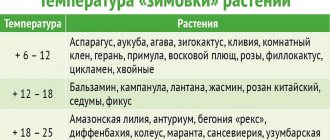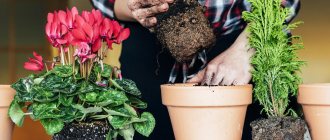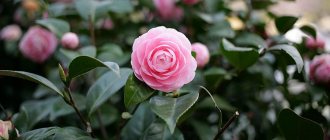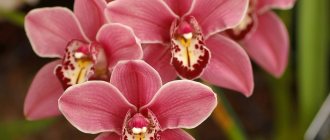Useful tips
Repotting indoor plants
Watering indoor plants
How to fertilize indoor plants
Plants that live in our homes are also influenced by lunar rhythms
, like all plants that grow in open ground. If you have indoor flowers at home, you already know from your own experience which of them take root best in your apartment, what care they require and how they behave, but if you feel that something is wrong with your plants, try caring for them. behind them in accordance with lunar rhythms.
If you are a beginner gardener, you will undoubtedly find our tips useful, following which you can boast of a beautiful garden on your windowsill
.
Indoor plants are not only pleasing to the eye and are the pride of any housewife. They bring a lot of benefits by ventilating the air
indoors and even
eliminating the harmful effects
of electrical appliances.
For example, it is not recommended to place flowering plants in the bedroom. Leafy plants are more suitable for this room.
, for example,
chlorophytum
or
helxina
, which will improve the microclimate and reduce harmful radiation.
Beautifully flowering plants
are suitable for the living room , for example,
hippeastrum
or
orchid
, which you can show off to your guests.
© vvoevale
It is important, of course, not to forget about the lighting capabilities of your apartment. For example, if your living room is very dark, flowers that love light will not take root in it without additional lighting.
.
Therefore, if you do not want to install additional lamps, it is better for you to place plants in such rooms that do not like light
, for example, such as
ferns, Abelia chinensis, anthurium, begonias, aglaonema, poinsettia, myrtle, spotted dieffenbachia, alocasia
and others.
© Hilda Weges | Photography
Transplanting flowers according to the lunar calendar - general rules
The growth and development of the plant will depend on the phase of the moon during transplantation.
Even in ancient times, it was possible to confirm the impact of the Moon on many organisms living on planet Earth. Flowers that grow both in the wild and at home are considered especially sensitive to phases.
The stage of development of the Moon when transplanting flowers in the future will determine how quickly they will take root and bloom. It is better not to ignore the recommendations of the calendar, since it helps determine the most suitable day for transplanting crops.
The lunar cycle consists of periods:
- new moon;
- growing moon;
- full moon;
- waning moon.
Flower growers are advised not to touch crops on the emerging and full Moon, since during this period all living organisms on Earth are too vulnerable and there is no need to injure them. During planting or transplanting, they most often simply die.
It is possible to establish the phase of the Moon in the following way: it is necessary to substitute a vertical line to the semicircle of the earth's satellite. During the growing phase, the letter “p” is formed, and the sign of the decreasing phase is the letter “c”. Only after determining the phase should a decision be made whether it was worth carrying out a transplant during this period or not.
The influence of moon phases on plants
If you want to work with flowers in accordance with the calendar recommendations, you must be familiar with the relationships between the phases and possible actions.
It is important for amateur flower growers to consider the following phases:
- New moon. During this period, it is not recommended to sow or replant any plants, including indoor flowers.
- Waxing Crescent. This phase has a fairly strong effect on the ground part of the flowers and weakly on their root system. At this time, it is allowed to plant and replant plants that develop above the surface of the earth. In addition, during the waxing moon phase, you can fertilize flowers with mineral elements, water the soil and do vaccinations.
- Full moon. During this period, it is better not to carry out any types of work with flowers. Only plant pruning and grafting are allowed.
- Waning moon. The phase affects the root system of flowers and less actively affects their above-ground part. During this period, it is allowed to plant bulbous plants, carry out fertilizing and pest protection measures.
Planting works best when the moon is waxing. The optimal time for transplantation is considered to be the period when the Moon is in Virgo. Carrying out work at this time has a positive effect on the restoration of the root system and the plant begins to grow quite quickly.
Types of jobs
For normal growth, plants should be provided with conditions for development:
- temperature regime. Depending on the type of vegetation, a certain room temperature is maintained. In summer, 23 degrees is a suitable temperature for most species. In winter, you should provide the environment necessary for growth, because at low temperatures the leaves darken, curl, and fall off. At high temperatures, the lower leaves wither and fall off;
- illumination Lack of daylight or sunlight can cause flowers to die;
- appropriate watering. In winter, almost all types of plants should be watered sparingly, except cacti and succulents. From spring to autumn - water abundantly, but do not allow waterlogging;
- air humidity. Most plants are afraid of a dry atmosphere, so during the operation of the heating system from autumn to spring, and during hot summers, it is better to spray the surface of the leaves with water;
- nutrition of roots and stems. Any plant needs nitrogen, roots need phosphate, flowers need potassium. The most effective way to feed is a liquid substance that evenly and quickly nourishes the roots. From spring to autumn, flowers should be fed regularly; in winter, feeding is significantly reduced or stopped;
- access to fresh air. Despite the fact that indoor vegetation produces oxygen, it needs an influx of fresh air. This reduces the temperature in summer, reduces humidity when flowers accumulate, and strengthens the stems. It is recommended to take plants outside during warm periods from spring to autumn;
- appearance care. The home bush must be cleaned of dust, pinched, tied up, trimmed, and old leaves removed. This needs to be done all year round.
The lunar calendar is scheduled for all months of the year. But there are a number of rules that are best adhered to when growing home flowers:
- Replanting in winter and autumn is undesirable.
- During the flowering period, the plant cannot be replanted, despite favorable days.
- Flowering varieties are replanted after flowering.
- Yellowed foliage indicates the need to change the soil layer.
- Young specimens can be replanted once a year.
- Solid plants growing in tubs and flowerpots are replanted every 5 years.
Important!
On unfavorable days, you can fertilize, loosen the soil, and treat against pests and pathogens.
The effect of the full moon on flowers
The Earth's satellite actively influences plant growth
During the full moon phase, the Earth is illuminated to the maximum by the Sun, saturated with its energy. All flowers, and especially the processes of sap flow in the plant, are subject to the influence of the Moon.
When the Moon passes through certain phases, a stretch occurs between the weak and strong gravitational points of the Earth. Water reacts especially vividly to this phenomenon with ebbs and flows.
The gravitational effect of the Moon on the growth of plants is negligible, because their sizes are quite small. It is for this reason that the movement of juices through tissues is not affected by the position of the Earth’s satellite.
However, observations have shown that the Moon still has an energetic rather than a physical effect on the plant. When determining days favorable for planting and transplanting, their bioenergy potential is taken into account.
Studies have shown that flowers react equally to the Earth's satellite both in open and closed ground. The full moon is the phase when their increased activity is noted.
Transplanting plants during the full moon
Many authors of lunar planting calendars say that during the full moon phase it is strictly forbidden to both plant and replant flower crops. The fact is that during this period their roots are too weakened.
There are also recommendations that during the full moon it is not allowed to do any work with indoor flowers. It is better not to plant, transplant, or even trim them.
The creators of other lunar calendars believe that during the full moon it is allowed to plant crops, but they should not be replanted.
Planting by seeds
There is a theory that during the full moon energy is actively consumed. In principle, it is possible to plant at this time, but there is a nuance: it is recommended only to sow, but not to replant seedlings with roots. This is due to the fact that activation of the plant’s energy potential during this period is possible only when its condition is stable, but not against the background of stress from transplantation. It has been experimentally proven that wheat sown during the full Moon germinates much faster than wheat whose grains were in the ground during the growing phase of the cycle. Similar results were obtained during an experiment on watercress. If you sow the seeds immediately before the full moon, then due to the accelerated process of activation and saturation with moisture, they will sprout quite quickly and amicably. This property is useful to take into account when sowing in dry summers or in hot areas.
During the full Moon, you can plant seeds of any above-ground vegetable crops, since they react especially actively to this phase. Productivity increases by 15-20%. As an example: during a full moon, a pumpkin increases its circumference by approximately 1 cm every day. Greens also gain leaf mass well at this time.
Comments (2)
Julia
08/31/2019 at 14:43 |
I rarely pay attention to the lunar calendar when planting plants. Maybe there is something in this, but it is far from the main thing. Astrologers also need to somehow earn a living by building horoscopes and publishing lunar calendars)Answer
Yulia Expert Plodogorod
08/31/2019 at 20:57 |
Hello Julia! You are right, for flower transplantation to go well, you need to take into account a whole range of factors, and not just lunar cycles. For example, it is important that the plant is in good condition and does not look lethargic or sick. After all, changing the soil and pot is still a lot of stress for your pet.
Although, sometimes with fungal and putrefactive lesions of the rhizome, an emergency transplant is required to save the plants. In such cases, the affected parts of the roots are often trimmed down to healthy tissue. In the described situation, when you need to act quickly, we are also not talking about following the lunar calendar.
But, besides this, the Earth’s satellite has a clear and scientifically proven impact on our planet. A striking example is the ebb and flow of tides. This influence, sometimes invisible to us, affects the development cycles of plants. Therefore, if you adhere to the described rules, the likelihood of a successful transplant or other impact on the flower is higher.
Answer
Moon in zodiac signs
The lunar disk passes through 12 zodiac signs, which influence the biorhythms of the night star. It is important for gardeners to know the following information:
- waning Moon in Scorpio and waxing in the sign of Capricorn - tubers and flower bulbs can be replanted;
- waning Moon in Cancer and growing in air signs, Scorpio and Pisces - you can replant decorative foliage plants;
- waning Moon in Sagittarius and Virgo, growing in Gemini - you can replant vines and hanging plant species.
Note! Favorable zodiac signs for working with plants are Scorpio, Taurus, Cancer, Libra, Capricorn and Pisces. Unfavorable signs are Aquarius and Leo.
If the moon passes through the constellation Aries, the plants do not perceive nutrients - fertilizing is useless.
The constellation Leo is also unfavorable for fertilizing, watering plants and treating pests.
It is best to plant seedlings and sow seeds when the waxing Moon passes through the constellation Virgo or the waning Moon is in the constellations Cancer or Scorpio.
Pruning and pinching of branches is best done when the waning Moon crosses the constellations Gemini or Aquarius.
How to replant a plant correctly
It’s not enough to choose the right time for such work with house plants. The following procedure for changing soil and container should be followed:
- choosing and preparing another pot for the plant;
- drainage device (if necessary);
- preparing a flower for transplantation;
- soil preparation.
Pests of indoor plants and diseases of indoor flowers
If the next place where the crop grows is a new pot, then it should be larger in size than the previous one. It is necessary to make a hole at the bottom of the container to drain excess water when watering. If the drainage holes are large, you can lay a piece of mosquito netting at the bottom. A stand - a bath under the bottom - is an integral attribute. It is needed so that the flowing water does not damage the coating of the shelf on which the container with the flower will be installed. New products must be washed with soap.
When used containers are used as a new home for a plant, they must be cleaned, washed and dried.
Carefully! The pot is selected one size larger than the previous one (4 cm). Too large a size promotes rapid growth of roots and shrinking of flowers. When the plant is sick, the size of the container is not changed.
Drainage, despite all the controversy surrounding it, is still needed. The holes do not provide quick drainage of excess water when watering. Drainage made from small pieces of various materials, laid in a fine layer on the bottom, will save the roots from rotting. Even if it reduces the working volume of soil, it will protect the plants if watering is improper.
For your information. For drainage, you can use brick chips, small pebbles, expanded clay, and crushed shards of broken plates. The prepared drainage must be disinfected in a 10% manganese solution.
The stages of preparing flowers for complete transplantation are as follows:
- preliminary abundant watering one day before work and an hour before excavation;
- removing the plant along with the soil, cleaning the roots from the old soil.
The soil mixture is first loosened by hand, slightly moistened. If the soil is not from the store, then it needs preliminary disinfection and the addition of vitamin B1 (two or three drops per pot). Disinfection is carried out by moderate calcination on a brazier placed on fire. As a last resort, pouring boiling water over the prepared soil will do. After which the cooled soil should dry to the desired condition.
Planting in a new container is carried out as follows:
- drainage is placed at the bottom;
- soil is poured onto the drainage in a pyramid;
- a flower is placed on the ground, the roots are straightened;
- New soil is poured around, to the level of the old mark on the trunk, and lightly compacted.
In order for the transplanted flower to take root after replanting, the room must be warm and have moderate humidity. It is not advisable to begin the planned transplantation before the beginning of April. Clear days and plantings on the waxing Moon are favorable companions for the gardener in this case. Drafts and direct sunlight on the flower are negative factors that prevent it from taking root.
Planting a flower in a pot
Unfavorable periods
The following periods are considered not very good for transplantation:
- New moon. The gravitational fields of the Earth's satellite and the Sun add up, increasing the pressure and saturation of the juices. Life forces are concentrated in the roots. Damage to the roots on new moon days can lead to the death of the plant.
- Two days before and after the new moon. The same processes occur as on the day of the new moon, only less pronounced. The above-ground part of the flower freezes and sap flow stops.
- Solar and Lunar eclipses. They disrupt the biorhythms of plants, inhibiting their growth and development. In addition, during the eclipse, solar activity changes, which disrupts the process of photosynthesis. The influence of eclipses is noted within 5-7 days before and after their occurrence.
When choosing the right period for transplantation, you need to take into account not only the recommendations of the Lunar calendar and the influence of the constellations, but also environmental conditions, the condition of the flower and the seasonality factor.
A timely transplanted flower quickly takes root, easily endures adversity and pleases the grower with lush flowering.
- Author: Maria Sukhorukikh
Rate this article:
- 5
- 4
- 3
- 2
- 1
(0 votes, average: 0 out of 5)
Share with your friends!
Common mistakes
- The soil is not updated. During planting work, new soil must be used. First, the new soil has more nutrients. Secondly, the old substrate may be infected with parasites or fungal spores.
- No drainage. The drainage system is very important. It prevents excess water from accumulating in the pot. When planting a flower in a new container, it is important to make drainage holes and add fine expanded clay or pebbles.
- Planting work is carried out inaccurately. When replanting, you must act very carefully so as not to damage the roots or break the stems of the flower. If the plant has grown deeply into the container, it is better to carefully cut it than to try to pull the flower out of the pot.
When is the best time to replant plants?
Automatic watering for indoor plants - do it yourself
In what month should flowers be replanted: June, February? If we talk about the best moment for transplantation, then you should choose the time from the end of February to April inclusive. The awakening of the plant, the growth of new shoots and leaves contribute to this event and will ensure normal growing season throughout the season.
Awakening the sprout
Replanting indoor flowers in autumn
The beginning of autumn is always associated with a decrease in ambient temperature. September and October are undesirable months for transplantation. It should only be done as a last resort. Plants are preparing for winter, and their vital processes are noticeably reduced. However, if you have to do this, you need to check the lunar schedule.











